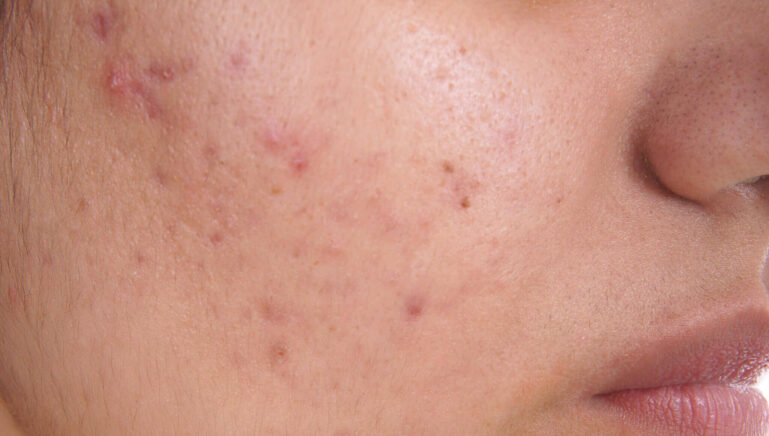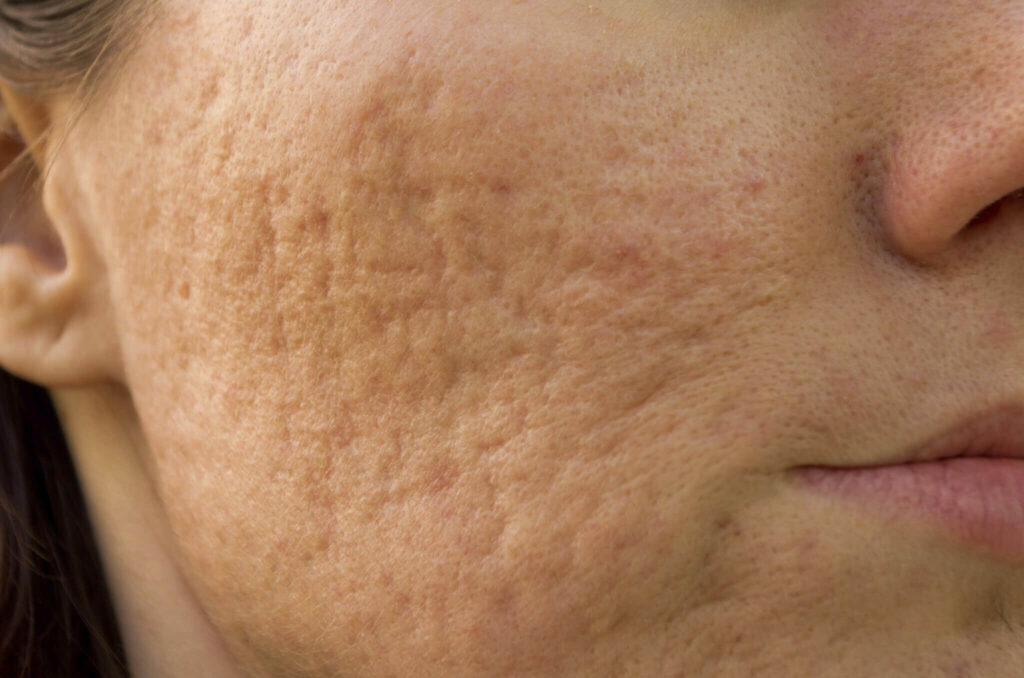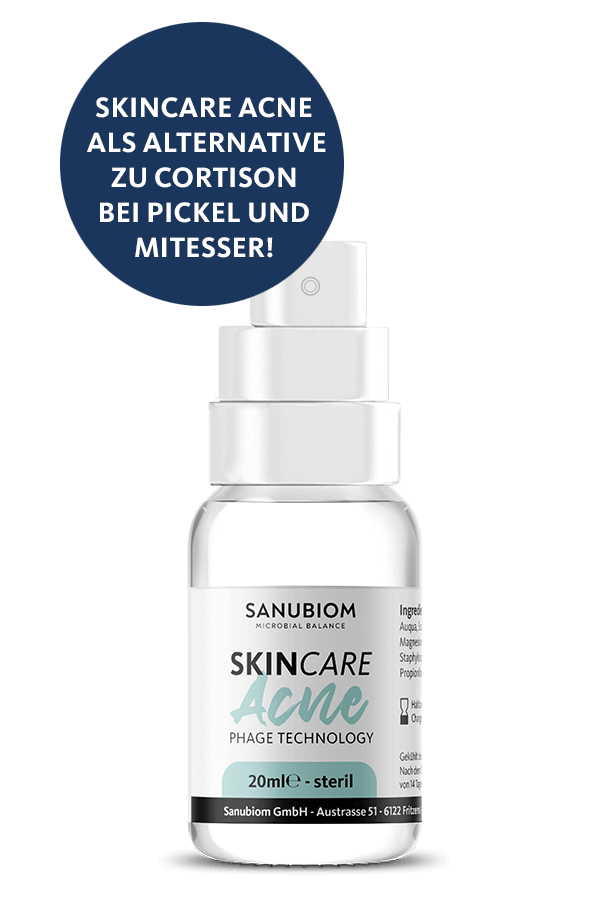Acne

Acne scars can not only affect the structure of the skin, but also affect self-confidence. In this detailed guide, we will take a close look at the nature of acne scars, the differences between them and pimple marks, the different types of scars and effective treatment methods and care tips. An in-depth knowledge of this topic is crucial to help people with acne conditions regain self-confidence and promote clear skin.
What are acne scars?
Difference between acne scars and pimple marks
Causes of acne scars
Types of acne scars
Treatment methods
Skin care and prevention
Costs and duration of treatments
Recommended products
FAQ
Acne scars are permanent skin changes that can occur after acne has healed. These scars are caused by impaired wound healing during or after an acne episode and can occur in various forms. the process of scarring is complex and depends on various factors.
It is important to understand that not every skin change after acne is necessarily a scar. Pimple marks are often temporary discolorations of the skin, while acne scars are structural changes. The distinction between these two is crucial for targeted treatment.

The formation of acne scars is often the result of deep-seated inflammation that impairs collagen production. When the skin tries to repair itself, it can lead to an uneven distribution of collagen, resulting in scarring. Understanding the underlying causes is the key to choosing the right treatment approaches.
Scarring after an acne episode is a highly complex biological process that is influenced by various factors. To better understand the development of acne scars, let’s take a detailed look at this process and the key factors that influence it.
1. inflammation and tissue damage:
The origin of most acne scars lies in deep inflammation of the skin caused by acne. If a pimple bursts or lies deep in the tissue, it can damage the surrounding skin layers and the underlying connective tissue. This damage leads to a disturbed skin structure and an increased need for healing.
2. collagen production:
Collagen is a crucial protein for skin elasticity and structure. During the healing process, the body tries to repair the damaged tissue by producing collagen. The way in which collagen is distributed plays a decisive role in the formation of acne scars. Uneven distribution can lead to irregular scars.
3. genetics:
Genetic predisposition plays an important role in wound healing and the tendency to scarring. Some people may have a higher tendency to form hypertrophic scars or keloids due to their genetic predisposition, while others are less prone to them.
4. skin type and pigmentation:
Skin type and pigmentation influence how the skin reacts to inflammation and tissue damage. People with darker skin may be more prone to excessive melanin production, which can lead to hyperpigmentation, while people with lighter skin may have more visible scars.
5. duration and intensity of inflammation:
The duration and intensity of the inflammation during the acne episode are decisive factors. Prolonged or intense inflammation can lead to an increased release of inflammatory messengers, which in turn can affect collagen production and contribute to uneven scarring.
6. professional treatments and self-treatment:
The way in which acne is treated can also influence scarring. Improper self-treatment, such as squeezing pimples, can lead to additional skin damage. At the same time, professional treatments, if applied early and appropriately, can help to minimize scarring.
7 Hormonal influences:
Hormonal changes, especially during puberty or the menstrual cycle, can increase sebum production and promote the development of acne. These hormonal fluctuations also influence the way the skin reacts to inflammation, which in turn influences scarring.
8. immune system:
The immune system plays a key role in wound healing and can influence the efficiency of the healing process. A weakened immune system can lead to slower or incomplete healing, which increases the likelihood of scarring.

SKINCARE ACNE
Probiotic skin protection SkinCare Acne with Phage Technology.
Your skin comes to rest.
There are different types of acne scars, which vary in shape and severity. The three main types are:
Atrophic scars
Atrophic scars are caused by a loss of skin tissue. They can appear as shallow or deep indentations in the skin.
Hypertrophic scars
Hypertrophic scars occur when too much collagen is produced during the healing process, resulting in raised scars.
Keloids
Keloids are similar to hypertrophic scars, but they grow beyond the original wound area.

Acne scar treatment includes various methods that are available depending on the scar:
Various laser techniques can improve the skin structure by stimulating collagen production and removing the upper layers of the skin.
These methods remove superficial layers of skin, making the skin texture smoother.
Acids help to remove the outer layer of skin and promote collagen production.
Fine needles are used to create tiny injuries, which stimulates collagen production.
This method involves removing scar tissue and acne scars through surgical procedures.
Icing flattens scars and improves the skin structure.
Collagen injections can fill in atrophic scars and make the skin smoother.
Cortisone can reduce hypertrophic scars by inhibiting inflammation.
In this method, the scar is treated with a highly concentrated acid to improve the skin structure.
Hyaluronic acid fillers can fill in deeper scars and tighten the skin.
A good skincare routine can help minimize the appearance of acne scars. Regular cleansing, exfoliation and moisturizing are crucial. Avoid squeezing pimples yourself to reduce scarring. In addition, products with ingredients such as retinol, vitamin C and hyaluronic acid should be integrated into the routine. A skin expert can make individual recommendations.
The costs and duration of treatments vary depending on the method and individual case. Laser therapy may require several sessions, while surgical procedures may have a longer recovery time. Open communication with the attending physician about expectations and possible risks is important.
Products with ingredients such as retinol, vitamin C and hyaluronic acid can improve the skin’s structure. It is advisable to seek advice from a skin expert before using such products. The selection of high-quality care products makes a decisive contribution to improving skin health.

SKINCARE ACNE
Probiotic skin protection SkinCare Acne with Phage Technology.
Your skin comes to rest.
It is about long-term depressions or elevations on the skin. Nevertheless, it is possible to minimize them with dermatological procedures such as peelings, lasers and dermabrasion. It is important to consult a dermatologist and the scars should only be treated once the acne has completely cleared up.
With the right treatments and care products, acne scars can be significantly improved, but complete disappearance may not always be possible.
However, therapy should only be carried out after the acne disease has been successfully overcome. Unfortunately, it is not possible to completely remove the scars. Nevertheless, it is possible to significantly soften the scars and make them appear less noticeable. In addition, your skin could possibly improve by itself over time.
Creams with retinol, vitamin C or hyaluronic acid can improve the skin structure. A dermatologist can recommend the best option for your skin type.
Natural home remedies such as aloe vera, honey and tea tree oil can help to reduce scars, but should be used with caution.
A dermatologist is the specialist for the treatment of acne scars. Consult a specialist for individual advice.
Just like other scars, acne scars also fade over time. However, this process can take several years and the scars often do not disappear completely. The speed at which the scars fade depends on the affected skin region, the skin type and the size of the acne scar.
Author: Katharina Hillinger
“Our skin nourishes, detoxifies and protects our body. But in order for it to fulfill its functions, our skin flora must be in balance. Healthy skin is characterized by a diverse ecosystem of microbes that form a kind of protective shield.”
Share post: